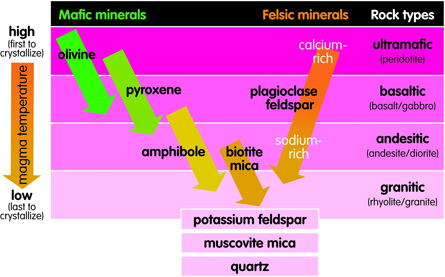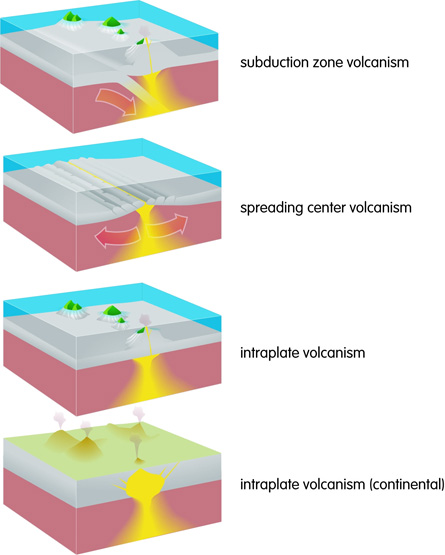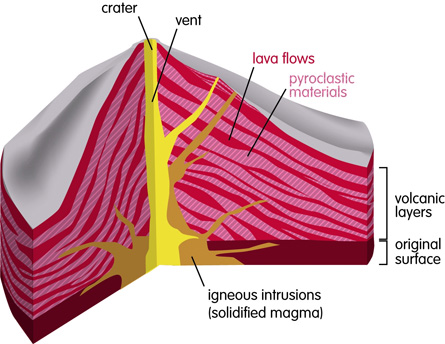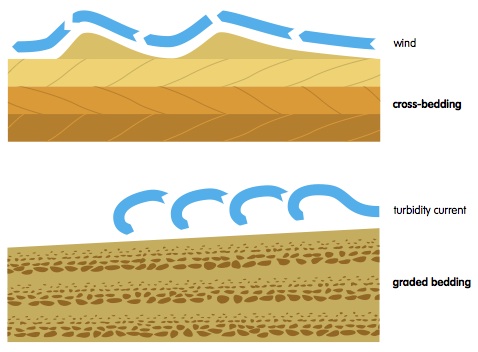Rocks and Their Environments
Rocks are aggregates of minerals.
Igneous Rocks
- As magma (molten material) cools, ions arrange themselves into orderly patterns during crystallization. There are two types of crystallization:
- Volcanic (extrusive): Magma crystallizes quickly at spreading centers and from volcanic eruptions.
- Plutonic (intrusive): Magma crystallizes slowly deep below the Earth’s surface.
- Magma’s rate of cooling affects crystal size and mineral composition.Fast cooling results in smaller crystals, more mafic; slow cooling results in larger crystals, more felsic.
- Glass: No crystals. Forms when magma cools too rapidly to form crystals.
- Fine-grained (aphanitic): Crystals too small to distinguish individual minerals with the unaided eye. Gas bubbles leave openings or vesicles. Aphanitic rocks form quickly at Earth’s surface or in the upper crust (volcanic).
- Coarse-grained (phaneritic): Crystals large enough to distinguish minerals with the naked eye. Phaneritic rocks form in a slowly cooling magma chamber deep in the crust (plutonic).
- Porphyritic: Large crystals in a matrix of smaller crystals. Porphyritic rocks form when magma crystallizes rapidly, forming a fine-grained matrix, but then moves to a slower-cooling environment before all the melt has crystallized. The remaining melt forms large crystals.
- Bowen’s reaction series: The geologist N. L. Bowen (1887–1956) created a chart showing the series in which different minerals crystallize from cooling magma:
- On the left side: Mafic minerals begin to crystallize. After each mineral crystallizes, it reacts with the remaining magma to form the next mineral in the series.
- On the right side: Felsic, calcium-rich minerals crystallize to form early feldspars, which then react with sodium in the remaining magma to form more sodium-rich feldspars.
- At the bottom of the series: When magma crystallization is nearly complete, the remaining magma is mostly SiO2, and quartz forms.

Volcanoes
- Volcanoes form where magma burns through the crust, at subduction zones, at spreading centers, or at “hot spots” like Hawaii.
- Successive eruptions build a cone of hardened lava. Eruptions are explosive (pyroclastic) if the magma is gas-rich and felsic, slow if the magma is gas-poor and mafic.
- Although volcanoes typically form at subduction zones or spreading centers, they also may form within a plate, as in the Yellowstone region of Wyoming.
- Volcano morphology
- Crater: The pit inside a volcano. A crater more than 1 km wide is called a caldera.
- Vent: A pipelike structure connecting the underground magma chamber to the crater.
- Types of volcanoes
- Shield volcano: A broad, slightly domed structure typically built of liquid basalt. The Hawaiian volcanoes are shield volcanoes.
- Composite cone (stratovolcano): A large, nearly symmetrical cone made of alternating lava flows and pyroclastic volcanic debris.
- Cinder cone: A generally small volcano with steep sides, built from ejected lava fragments and often in groups near larger volcanoes.
- Volcanic rocks
- Basalt: Dark green to black, fine-grained, mostly pyroxene and plagioclase feldspar, with some olivine. The ocean floor is mostly basalt.
- Tuff: Hardened ash from an explosive volcano.
- Plutons are the site of plutonic rock formation. Most magma in the Earth is deep underground, in chambers that cool slowly or rise slowly to intrude into preexisting rock.
- Plutonic rocks
- Gabbro: Has a basaltic composition (mafic) but large grain size.
- Granite: A phaneritic igneous rock with 25–35% quartz and more than 50% feldspar, with hornblende, muscovite and biotite.
- Pluton forms
- Batholith: A large expanse of granitic rock (more than 100 km2). Batholiths frequently form the cores of mountains, exposed only after much of the ground surface erodes.
- Sill: A lateral layer of igneous rock formed when fluid basaltic magma rises from a magma chamber and squeezes into horizontal strata.
- Dike: A vertical or angled layer of igneous rock that cuts across other rock layers, usually by injection into fractures.


Metamorphic Rocks
- High temperature, high pressure, or variable chemical conditions can changecountry (preexisting) rocks through the process of metamorphism.Rocks remain solid during the process.
- Regional metamorphism: An extensive volume of the crust is metamorphosed, usually by intensive compression at convergent boundaries.
- Contact metamorphism: Intruding magma heats cold country rock nearby and causes it to recrystallize.
- Metasomatism: Hot fluids dissolve original minerals, and then chemical reactions cause new minerals to grow.
- Rocks undergo both mineral and textural changes during metamorphism.
- Mineral changes: During metamorphism, two minerals can react, and their ions can diffuse across grain boundaries, resulting in a new mineral. Alternatively, complex minerals may break down into simpler ones.
- Textural changes: Rocks gain foliation (alignment) as minerals align into bands. With increasing temperature and pressure, grain size increases and texture coarsens.
- Classification: Metamorphic rocks are classified by strength of metamorphism. The following are listed in order from weak to strong metamorphism:
- Foliated rocks:
- Slate: A fine-grained rock, usually made of metamorphosed fine sediments.
- Phyllite: Similar to slate but slightly coarser-grained, and shiny due to high mica content.
- Schist: A coarse-textured metamorphic rock, with minerals aligned in parallel bands, containing more than 50% platy minerals (minerals with a planar, layered structure) like mica.
- Gneiss: Bands of abundant coarse grains, mostly feldspar and quartz, alternated with bands of flaky minerals.
- Nonfoliated rocks:
- Marble: Metamorphosed limestone with a sugary texture. Marble is composed of interlocking calcite grains.
- Quartzite: Metamorphosed quartz sandstone. Quartzite is very hard and is composed of interlocking quartz grains.
- Hornfels: Fine-grained rock altered in contact zones around igneous intrusions.
Sedimentary Rocks
- When weather and other forces of erosion wear away rocks, sediments form. Those sediments can be compacted, through lithification, to form sedimentary rocks.
- Erosion: The transport of material around Earth’s surface by a mobile agent like water or wind. Erosion and weathering form sediments and soil.
- Mechanical (physical) weathering: Rocks break into smaller pieces, with each piece retaining the original mineral composition.
- Frost wedging: Water freezes and expands in a rock, breaking off fragments.
- Unloading: Erosion removes material from above buried rock. Pieces pop off in response to the lowered pressure.
- Biological activity: Roots wedge into and widen rock fractures, or animals burrow into soil and expose rock to the surface.
- Chemical weathering: Rocks break down chemically, and their constituent minerals alter during the process.
- Oxidation: Water (H2O) is the strongest chemical weathering agent. It causes iron-rich rocks to oxidize, or rust.
- Ionization: CO2 + H2O → carbonic acid, which breaks granite down into clay minerals.
- Lithification: After erosion and weathering, sediments cement to form sedimentary rocks.
- Sedimentary settings: Sedimentary rocks can form anywhere on or just below the Earth’s surface, in dry or wet environments.
- Classification: Sedimentary rocks may be classified in several different ways:
- Based on origin:
- Detrital sediments: Sediments that are fragments of broken-down rock. They are listed here in order of decreasing grain size:
- Breccia: Lithified angular blocks of rock.
- Conglomerate: Lithified round rock fragments, pebble-sized and larger.
- Sandstone: Cemented sand.
- Shale: Compacted clay, mud, or silt.
- Chemical and biochemical sediments: Sediments that form from minerals that precipitate from water, either physically or biologically (as organisms pull elements out of water to make their skeletons):
- Limestone (CaCO3): Formed from cemented fragments of any size of shell.
- Chert: Cemented shells made of silica.
- Evaporites: Sediments that form as water evaporates from a closed basin and the solution becomes supersaturated with certain elements, which then precipitate out as minerals like halite.
- Coal: An organic material that nonetheless is considered a sedimentary rock because it consists of compacted plant matter.
- Based on grain size and sorting:
- Grain size: The physical size of individual grains that make up sedimentary rock.
- Gravel (>2 mm) forms conglomerate, breccia
- Sand (1/16–2 mm) forms sandstone, greywacke
- Mud (<1/16 mm) forms shale, mudstone
- Sorting: The degree of variety of grain size and composition within a sedimentary rock.
- Well sorted: One grain size and type dominates the rock’s composition.
- Poorly sorted: The rock is composed of grains of many sizes and compositions.
- Based on sedimentary structure:
- The method of sediment deposition often imparts a distinctive pattern on a package of sedimentary rocks.
- Bedding planes: The planes that separate strata (layers) of sedimentary rock. Often, these planes are the planes along which the rock breaks.
- Cross-bedding: Wind or waves deposit sediments in an upsweeping pattern.
- Graded bedding: Grain size becomes coarser or finer from the bottom to the top of a layer.

The Rock Cycle
- Heat, pressure, erosion, and other forces are always at work on the Earth, changing the composition of rocks: from igneous to sedimentary, sedimentary to metamorphic, igneous to metamorphic, and so on.
- These continual conversions from one type of rock to another are collectively termed the rock cycle.
- All rocks exposed at Earth’s surface are subject to weathering,which leads to the formation of sediments.
- All sediments are subject to burial, after which they are undergolithification (cementation and compaction) to form sedimentary rocks.
- All rocks can be exposed to heat and pressure, which often leads to formation of metamorphic rock.
- When metamorphic rocks melt into magma, the magma sometimes cools and crystallizes into igneous rock


No comments:
Post a Comment